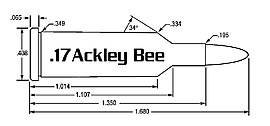This article has multiple issues. Please help improve it or discuss these issues on the talk page . (Learn how and when to remove these messages)
|
| .17 Ackley Bee | ||||||||||||
|---|---|---|---|---|---|---|---|---|---|---|---|---|
 | ||||||||||||
| Type | Rifle | |||||||||||
| Place of origin | United States | |||||||||||
| Production history | ||||||||||||
| Designer | P.O. Ackley | |||||||||||
| Designed | 1940s | |||||||||||
| Specifications | ||||||||||||
| Parent case | .218 Bee | |||||||||||
| Case type | Rimmed, bottleneck | |||||||||||
| Bullet diameter | 0.172 in (4.4 mm) | |||||||||||
| Neck diameter | 0.195 in (5.0 mm) | |||||||||||
| Shoulder diameter | 0.334 in (8.5 mm) | |||||||||||
| Base diameter | 0.349 in (8.9 mm) | |||||||||||
| Rim diameter | 0.408 in (10.4 mm) | |||||||||||
| Rim thickness | .065 in (1.7 mm) | |||||||||||
| Case length | 1.35 in (34 mm) | |||||||||||
| Case capacity | 16.89 gr H2O (1.094 cm3) | |||||||||||
| Rifling twist | 1-12 inches | |||||||||||
| Primer type | Small rifle [1] | |||||||||||
| Ballistic performance | ||||||||||||
| ||||||||||||
| Source(s): Reload Bench [2] | ||||||||||||
The .17 Ackley Bee is a wildcat centerfire rifle cartridge named after its designer, P.O. Ackley, and is a .218 Bee case necked down to .17 caliber with a sharper shoulder and less body taper. Being a rimmed case, it was popular in single shot rifles such as the Martini Cadet and Low Wall Winchester. [2] The caliber is well suited to varmint hunting particularly where minimal pelt damage is required.[ citation needed ]
